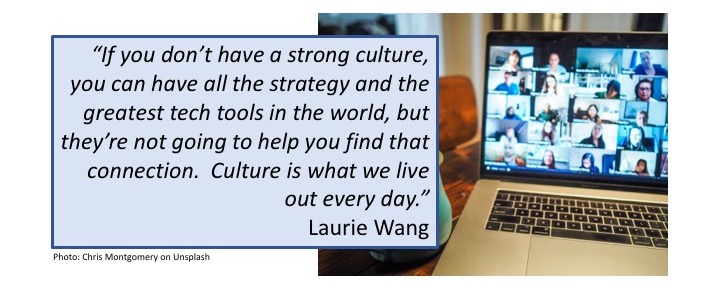When you reflect on pre-pandemic times, it feels like reminiscing about the ‘good old days’. Remember when you could walk into a building and get a sense of the workplace culture just by the buzz in the room? Successful organizations had a certain energy that was upbeat, invigorating and appealing. There was an aura you couldn’t quite identify, but it reinforced the feeling you had made the right decision forming a relationship with them as a customer, partner or employee.
Workplace culture is the glue that binds the most desirable qualities of diverse individuals into a focused, productive and comfortable collective undertaking. As an organization grows with purpose and intention, its culture becomes the living embodiment of its values, particularities and relationships. While intangible, workplace culture is a powerful, living entity. A positive culture can shine a spotlight on a company’s accomplishments, while a negative culture can irreparably taint an otherwise desirable product. Effective managers are constantly aware of the state of their workplace culture because so much hinges on it: employee satisfaction, performance, the ability to attract talent, and the quality of relationships – both internal and external.
However, as we all discovered in the spring of 2020, just when organizations thought they had culture well in hand, along came a pandemic which forced employees to scramble for their home offices and managers to learn the intricacies of orchestrating Zoom meetings. As many corporations turned their attention towards the mission of simply staying afloat after colliding with a pandemic, managers failed to realize workplace culture hadn’t always found a seat in the lifeboats.
Building culture can be a challenging and time-consuming endeavour even when working under ideal circumstances, such as a robust economy and an office design that promotes engagement. One of the cornerstones of developing and sustaining culture is communication, and when that critical element is reduced to emails and weekly Zoom calls, many subtle but vital nuances that we take for granted in a face-to-face environment can disappear. On top of that, many employees have discovered they enjoy working from home and have demonstrated they can maintain or increase their productivity. With virtually no time spent commuting, and a greater work-life balance, employees are willing to work from home indefinitely, while business owners and managers are making plans to occupy smaller, more affordable spaces.
On the surface, it seems like a win-win, but how do companies continue to nurture workplace culture when the workplace itself has fractured? We talked to prominent Edmonton-area business leaders about their experiences.

Culture helps a company define who they are and who will excel within the organization.
“Everyone who joins a company should fit in the culture,” says Scot Rutherford of Robert Scot Ltd. “Think of workplace culture as a ball of clay and each new employee is a piece of fresh clay added to the ball. When you add a new employee, the ball should roll stronger and smoother, otherwise there will be bits of clay flying everywhere. A clearly identified culture helps you define and find that elusive ‘it’ quality you look for when hiring new employees.”
An organization’s values are the bedrock of the culture. Make sure they’re visible so they are never in question. As employees spend time with an organization, they learn to consider the corporate values intuitively when making decisions. People who are hoping to join the company should be asked to discuss how those values currently play a role in their lives. Once you have identified and hired the right people, you need to be specific in your attention to onboarding them.
Online onboarding – take the time to do it effectively
“As a new employee is getting acclimated, you should never simply ask them how things are going, especially not during a pandemic or remote work situation,” says Scot. “A new employee’s first instinct will be to tell you ‘things are fine’. Ask specific questions that allow the employee to tell you what he or she has observed or has questions about. In my experience, successful onboarding doesn’t happen in a few weeks or even months. It’s probably going to take a year, especially if it’s happening virtually.”
When working with a new employee remotely, it’s important to let that individual know your expectation of the onboarding timeframe and process. Working from home, they may feel they are taking up too much of their supervisor’s time as each question requires a new email, text or phone call. Encourage communication so they don’t feel lost or abandoned and remind them to be patient with their own progress.

Never underestimate the importance of Culture
Laurie Wang, a local Communications and PR Director from Legal Aid Alberta, shared her favourite Peter Drucker quote with us. “Drucker said, ‘Culture eats strategy for breakfast’. That inspired a meme which says, ‘Culture eats strategy for breakfast and technology for lunch’. If you don’t have a strong culture, you can have all the strategy and the greatest tech tools in the world, but they’re not going to help you find that connection. Culture is what we live out every day.”
Some of the things organizations used to take for granted, such as clear communication and instant feedback, are harder to accomplish during times like this. “For example, I believe a performance review should never be a surprise. Pre-pandemic, if something came up and I wanted to discuss it with an employee, I’d just walk down the hall and we’d chat. There was constant communication. Now, I have to schedule a fifteen-minute online meeting and it feels like “come to the principal’s office”. Managers need to make sure an invitation carries the appropriate ‘tone’ as well as clear information so the employee isn’t wrestling with needless anxiety as they wait for a meeting.”
In a remote work environment, inclusion takes work
Laurie also feels it’s important to include everyone in virtual meetings. “Sometimes, with larger groups, you have a handful of people who do most of the talking so, whenever time allows, we end meetings with a one minute round table – everyone gets a minute to contribute their thoughts at the end so no one feels as if they weren’t heard.”
In her own meetings, Laurie goes one step further. “It’s also important that people have their videos on. Otherwise you can’t read the room and you don’t know if people are truly engaged.”
Words matter
Communication is a key to developing and maintaining culture and words are important.
“Choosing a name for your event can demonstrate your culture. Certain words trigger a response and set the tone. A ‘Leadership Touchpoint’ may be more effective than a ‘town hall’. A ‘virtual event’ may be more appealing than a ‘webinar’. A webinar feels like a one-way communication while a virtual event feels inclusive.”
According to Laurie, establishing a good culture fit starts in the hiring interview.
“When I’m in an interview to join an organization, I ask each person who is interviewing me ‘The last time you had a really good day at work, what did that look like?’ Some may say, ‘I had coffee with a friend’, others might say “I shared my presentation with my team and received some really powerful feedback”. You get a strong sense of the culture from their answers. If I’m hiring, I ask the same question. It works both ways.”

Culture and conflict
“Culture has been critical to me for the last 20 years,” says Tara Madden, Director of Communications for the Professional Association of Resident Physicians of Alberta. “I’ve always worked in organizations with a small employee base and that can be challenging. When you only have a handful of staff in a small space and there’s a conflict, it becomes so much more evident. Everyone is aware of what is going on. Of course, conflict is going to happen, but when you have a strong, positive culture, it’s also much easier to resolve it.”
Working online has its own set of challenges. Even if you have a solid culture and a good working relationship with a person, it’s easy to misinterpret ‘tone’ in an email or text. If you’re struggling to form the right message, make a phone call. Same thing if you receive an email; it may sound terse but maybe the sender was just in a hurry. Managers should let employees know they’re open to a call if clarification is needed.
The power of culture
“In my initial interview, the supervisor demonstrated the organization’s commitment to a strong work / life balance which was important to me,” recalls Tara. “I probably had more qualifications than the job demanded at the time, but I came away with a sense of what the organization really valued and I made the decision to accept the job because of the culture. I know the organization is supportive of me, understands the needs of raising a family and provides opportunity for growth, and in return, I would do anything for them.”
A little extra effort goes a long way
It’s important to know how to express your culture in words, but nothing compares to seeing it in action. In a pandemic world, managers need to be creative and find ways to demonstrate the culture within the existing communication parameters.
“Over the past year my CEO has legit emailed us every morning,” says Tara. “At 8 am we receive a personal note; it’s brief, but positive, reminding us to protect our own wellbeing, get out and get a break. It’s the connection piece, it’s the inherent caring and concern that these are even being written. The notes are personal and individual, and that has truly made us feel connected. It puts a smile on my face every morning, in a time when there hasn’t been a lot to smile about.”
Regularly scheduled meetings still take place, but as Tara explains, “I think what falls away is we start to feel more isolated because we’re spending more and more time alone. We miss those organic conversations that often have nothing to do with work, when you pass in the hallway or gather in the lunchroom. That’s where rapport and relationships really get built and you learn you can lean on these people. Recently our supervisor called a Zoom meeting during which we could talk about anything except work. We shared personal stories, we laughed and, what really stood out for me was how much I like these people and how much I’d missed this.”
Develop a new normal
With less direct contact in a pandemic world, and the expectation it will continue in a post-pandemic environment, culture still relies on good communication although the parameters for that are changing.
“I’ve sensed we are establishing a new set of boundaries,” explains Tara. “We are now working from our intimate, personal surroundings so, inevitably, our personal and private lives overlap. The things we were always cautious of previously – giving out personal phone numbers, answering phone calls after hours, texting people randomly – are the things I’ve had to embrace more because that’s the way I can stay connected to the people I’m not seeing. I find myself being very aware of establishing the new boundaries between home and work while still keeping myself a little more available than I might have been if I was still working in the office.”

Asking leaders to step forward
“Culture grows from many things but it starts with leadership,” says Marty Forbes, President of Radio Wise Inc. and local media/marketing consultant. “A good organization understands that when the culture is working, other people become leaders. Someone who has been there for a year becomes a leader to someone who has been there for a month and the established people are consistently demonstrating the culture to the new people. Even in a video conference, it could be as simple as demonstrating they’re comfortable speaking up or holding each other accountable to the values from which the culture has emerged.”
According to Marty, leadership and culture both rely on solid communication.
“When I became a General Manager, every new employee would meet with me on their first day and we’d talk about them – not just their work experience, but their life outside of work, their kids, their interests. I wanted to get to know them on a personal level and discover what we had in common so we had a connection to build on. When they left the office, I made sure they walked out with some radio station gear so they felt like part of the team. As remote working becomes more commonplace, it’s essential for managers to find new ways to make that initial connection.”
Small actions have big impact
“The advice I would give anyone who leads is that even a small gesture can have a large effect,” says Marty. “Since we can’t always connect in person, use the technology beyond what people expect from you. My dad was General Manager of 630 CHED many years ago, and when he heard a good story about one of his employees, he would give them a call on a Saturday afternoon just to chat and say thank you or congratulations. Imagine how impactful that must have been – the boss calling out of the blue on a Saturday just to say thanks for a good job. For my dad, it meant investing a few minutes of his time. For the people who got the phone call, it was something they’d always remember, and hopefully emulate when they moved into a supervisory role. Someone could easily do the same thing today. You could also send an unexpected email, but just imagine the power of a handwritten note showing up in the mail. Culture thrives on connection and connection matters to people. Managers need to find ways to connect – your connection doesn’t stop just because the meeting ends. The thing about leadership and communication is you never turn it off and it has to be genuine.”
Marty drew from his own personal experiences when he had the chance to create a culture of his own.
“More than once, a positive culture was influential in me staying with a job and that’s ultimately the bottom line. When someone is exposed to your culture, they should think ‘This is something I want to be a part of’. Make that your goal and you’ll find a way to use the technology to get there.”
Moving forward
Culture. It’s the face of your organization to your customers, your partners and your staff, and it influences every decision a company makes. It requires a substantial amount of attention under ideal circumstances and even more during a pandemic when your team is working remotely. We’re all sailing in uncharted waters and learning to find our way forward. Focus on communication, engage through creativity and remember that thoughtful little extras go a long way.
If you’ve had some positive experiences with building culture remotely that you’d like to share, let us know and we’ll pass them along in future newsletters.
Photo: Bonnie Kittle on Unsplash
